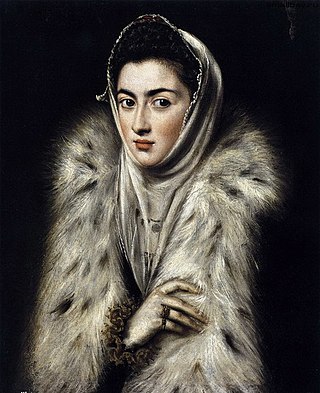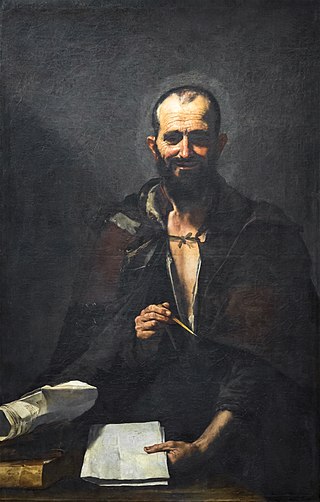
Miguel de Cervantes Saavedra was an Early Modern Spanish writer widely regarded as the greatest writer in the Spanish language and one of the world's pre-eminent novelists. He is best known for his novel Don Quixote, a work considered as the first modern novel. The novel has been labelled by many well-known authors as the "best book of all time" and the "best and most central work in world literature".

The Museo del Prado, officially known as Museo Nacional del Prado, is the main Spanish national art museum, located in central Madrid. It houses collections of European art, dating from the 12th century to the early 20th century, based on the former Spanish royal collection, and the single best collection of Spanish art. Founded as a museum of paintings and sculpture in 1819, it also contains important collections of other types of works. The numerous works by Francisco Goya, the single most extensively represented artist, as well as by Hieronymus Bosch, El Greco, Peter Paul Rubens, Titian, and Diego Velázquez, are some of the highlights of the collection. Velázquez and his keen eye and sensibility were also responsible for bringing much of the museum's fine collection of Italian masters to Spain, now one of the largest outside of Italy.

Francisco de Zurbarán was a Spanish painter. He is known primarily for his religious paintings depicting monks, nuns, and martyrs, and for his still-lifes. Zurbarán gained the nickname "Spanish Caravaggio", owing to the forceful use of chiaroscuro in which he excelled.

Pedro de Orrente was a Spanish painter of the early Baroque period who became one of the first artists in that part of Spain to paint in a Naturalistic style.

Friar Juan Bautista Maíno, or Mayno was a Spanish Baroque painter.

Portrait of Pablo de Valladolid is a portrait painted around 1635 by Diego Velázquez of Pablo or "Pablillos" de Valladolid (1587–1648), a jester and actor at Philip IV's court from 1632 until his death. It is now in the Museo del Prado, to which it was moved in 1827.

The Monastery of Saint Dominic of Silos (the Old) (Spanish: Monasterio de Santo Domingo de Silos (el Antiguo)) is a Cistercian convent in Toledo, Spain.

The Museum of Santa Cruz is an art, archaeology and ethnographic museum located in the historic centre of the city of Toledo, Spain. It exhibits collections pertaining to the province of Toledo, including works painted by El Greco in the city of Toledo.

The Nobleman with his Hand on his Chest is an oil painting by El Greco, one of the earliest works painted by the artist in Spain.

Retrato de un médico is an oil painting by El Greco.

The El Greco Museum is a single-artist museum in Toledo, Spain, devoted to the work and life of El Greco, who spent much of his life in Toledo, having been born in Fodele, Crete. It is one of the National Museums of Spain and it is attached to the Ministry of Culture.

Matías Moreno González was a Spanish painter, sculptor, art restorer and copyist; primarily of works by El Greco.

Lady in a Fur Wrap is an oil painting now generally attributed to Alonso Sánchez Coello, dated to 1577-1579 and now held at the Pollok House in Glasgow.

Portrait of an Elderly Man or Portrait of an Old Nobleman is a 1597-1600 oil on canvas portrait by El Greco, now in the Prado Museum. Its subject's name is unknown but he probably came from Toledo, where the artist was then working. It was stored in the basement of the Real Alcázar of Madrid.

Portrait of a Nobleman is a c.1586 oil on canvas portrait by El Greco, originally hung in the Quinta del Duque del Arco in Royal Palace of El Pardo in Madrid but now in the Museo del Prado. Its subject is unknown.

Portrait of a Young Nobleman is a 1600–1605 oil on canvas portrait by El Greco, originally in the quinta del Duque del Arco at the Royal Palace of El Pardo in Madrid but now in the Museo del Prado. It was long thought to show the poet Baltasar Elisio de Medinilla, but this has been disproven, and its subject is now unknown. It appears to have been influenced by portraits by Titian and Tintoretto, who El Greco knew whilst in Venice.

Portrait of Jerónimo de Cevallos is a 1609-1613 work by El Greco, from late in his Toledo period. It originally hung in the Quinta del Duque del Arco in the Royal Palace of El Pardo in Madrid but now in the Museo del Prado.

Saint John the Evangelist is a c.1605 work by El Greco, produced towards the end of his time in Toledo, Spain. It now hangs in the Museo del Prado, to which it was left in 1921 by the collector César Cabañas Caballero.

Democritus is an oil on canvas painting by Jusepe de Ribera, executed in 1630, now in the Museo del Prado, in Madrid. It is believed to depict the Ancient Greek philosopher Democritus.



















